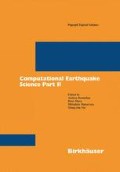Abstract
All earthquakes are followed by an aftershock sequence. A universal feature of aftershock sequences is that they decay in time according to the modified Omori’s law, a power-law decay. In this paper we consider the applicability of damage mechanics to earthquake aftershocks. The damage variable introduced in damage mechanics quantifies the deviation of a brittle solid from linear elasticity. We draw an analogy between the metastable behavior of a stressed brittle solid and the metastable behavior of a superheated liquid. The nucleation of microcracks is analogous to the nucleation of bubbles in the superheated liquid. In this paper we obtain a solution for the evolution of damage after the instantaneous application of a constant strain to a rod. We show that the subsequent stress relaxation can reproduce the modified Omori’s law. It is argued that the aftershocks themselves cause random fluctuations similar to the thermal fluctuations associated with phase transitions.
Access this chapter
Tax calculation will be finalised at checkout
Purchases are for personal use only
Preview
Unable to display preview. Download preview PDF.
References
Ben-zion, Y. and Lyakhovsky, V.2002, Accelerated Seismic Release and Related Aspects of Seismicity Patterns on Earthquakes Faults, Pure Appl. Geophys. 159, 2385–2412.
Buchel, A. and Sethna, J. P.1997, Statistical Mechanics of Cracks: Fluctuations, Breakdown, and Asymptotics of Elastic Theory, Phys. Rev. E 55, 7669–7690
Ciliberto, S., Guarino, A., and Scorretti, R.2001, The Effect of Disorder on the Fracture Nucleation Process, Physica D 158, 83–104
Das, S. and Scholz, C. H. 1981, Theory of Time-dependent Rupture in the Earth, J. Geophys. Res. 86, 6039–6051.
Debenedetti, P. G., Metastable Liquids, Princeton University Press, Princeton 1996.
Dieterich, J. H. 1994, A Constitutive Law for Rate of Earthquake Production and its Application to Earthquake Clustering, J. Geophys. Res. 99, 2601–2618.
Freund, L. B. Dynamic Fracture Mechanics (Cambridge University Press, Cambridge 1990).
Gluzman, S. and Sornette, D. 2001, Self-consistent Theory of Rupture by Progressive Diffuse Damage, Phys. Rev. E 63, 066–129.
Guarino, A., Garcimartin, A., and Ciliberto, S.1998, An Experimental Test of the Critical Behavior of Fracture Precursors, Eur. Phys.J.B6, 13–24.
Guarino, A., Ciliberto, S., and Garcimartin, A.1999 Failure Time and Microcrack Nucleation, Europhys. Lett. 47, 456.
Johansen, A. and Sornette, D.2000, Critical Ruptures, Eur. Phys.J.B18, 163–181.
Kachanov, L. M., Introduction to Continuum Damage Mechanics, (Martinus Nijhoff, Dordrecht, Netherlands 1986
Krajcinovic, D., Damage Mechanics, (Elsevier, Amsterdam 1996).
Kun, F. and Herrmann, H. J.1999, Transition from Damage to Fragmentation in Collision of Solids, Phys. Rev. E 59, 2623–2632.
Lemaitre, J. and ChabocheJ.L., Mechanics of Solid Materials, (Cambridge University Press, Cambridge 1990).
Lyakhovsky, V., Ben-Zion, Y., and Agnon, A.1997, Distributed Damage, Faulting and Friction, J. Geophys. Res. 102, 27,635–27,649.
Mogi, K. (1962), Study of Elastic Shocks Caused by the Fracture of Hetergeneous Materials and its Relations to Earthquake Phenomena, Bull. Earthq. Res. Insti. 40, 125–173.
Nakanishi, H.1992, Earthquake Dynamics Driven by a Viscous Fluid, Phys. Rev. A 46, 4689–4692. Nakatani, M. 2001, Conceptual and Physical Clarification of Rate and State Friction: Frictional Sliding as a Thermally Activated RheologyJ.Geophys. Res. 106, 13,347–13,380.
Otani, H., Phoenix, S. L., and Petrina, P.1991, Matrix Effects on Lifetime Statistics for Carbon Fibre-epoxy Microcomposites in Creep Rupture, J. Mat. Sci. 26, 1955–1970.
Reasenberg, P. A. and Jones, L. M. 1989, Earthquake Hazard after a Mainshock in California, Science, 243, 1173–1176.
Rundle, J. B., Klein, W., and Gross, S. 1996, Dynamics of a Traveling Density Wave Model for Earthquakes, Phys. Rev. Lett. 76, 4285–4288.
Rundle, J. B., Klein, W., and Gross, S. 1999, Physical Basis for Statistical Patterns in ComplexEarthquake Populations: Models, Predictions and Tests, Pure Appl. Geophys. 155, 575–607.
Rundle, J. B., Klein, W., Turcotte, D. L., and Malamud, B. D.2000, Precursory Seismic Activationand Critical Point Phenomena, Pure Appl. Geophys. 157, 2165–2182.
Scholz, C. H., The Mechanics of Earthquakes and Faulting, 2nd ed. (Cambridge University Press, Cambridge 2002
Selinger, R. L. B., Wang, Z. G., Gelbart, W. M., and Ben-Shaul, A. 1991 Statistical-thermodynamic Approach to Fracture, Phys. Rev. A 43, 4396–4400.
Shaw, B. E. 1993, Generalized Omori Law for Aftershocks and Foreshocks from a Simple Dynamics, Geophys. Res. Let. 20, 907–910.
Shcherbakov, R. and Turcotte, D. L. 2003, Damage and Self-similarity in Fracture, Theor. Appl. Frac. Mech. in press.
Sornette, D. and Andersen, J. V. 1998, Scaling with Respect to Disorder in Time-to-failure, Eur. Phys. J. B 1, 353–357
Turcotte, D. L., Newman, W. I., and Shcherbakov, R.2003, Micro-and Macroscopic Models of Rock Fracture, Geophys. J. Int. 152, 718–728.
Wu, H. F., Phoenix, S. L., and Schwartz, P. 1988, Temperature Dependence of Lifetime Statistics for Single Kevlar 49 Filaments in Creep-Rupture, J. Mat. Sci. 23, 1851–1860.
Zapperi, S., Ray, P., Stanley, H. E., and Vespignani, A. 1997, First-order Transition in the Breakdown of Disordered Media, Phys. Rev. Lett. 78, 1408–1411.
Zapperi S., Ray, P., Stanley, H. E., and Vespignani, A.1999, Avalanches in Breakdown and Fracture Processes, Phys. Rev. E 59, 5049–5057.
Author information
Authors and Affiliations
Editor information
Editors and Affiliations
Rights and permissions
Copyright information
© 2004 Springer Basel AG
About this chapter
Cite this chapter
Shcherbakov, R., Turcotte, d. (2004). A Damage Mechanics Model for Aftershocks. In: Donnellan, A., Mora, P., Matsu’ura, M., Yin, Xc. (eds) Computational Earthquake Science Part II. PAGEOPH Topical Volumes. Birkhäuser, Basel. https://doi.org/10.1007/978-3-0348-7875-3_19
Download citation
DOI: https://doi.org/10.1007/978-3-0348-7875-3_19
Publisher Name: Birkhäuser, Basel
Print ISBN: 978-3-7643-7143-2
Online ISBN: 978-3-0348-7875-3
eBook Packages: Springer Book Archive

